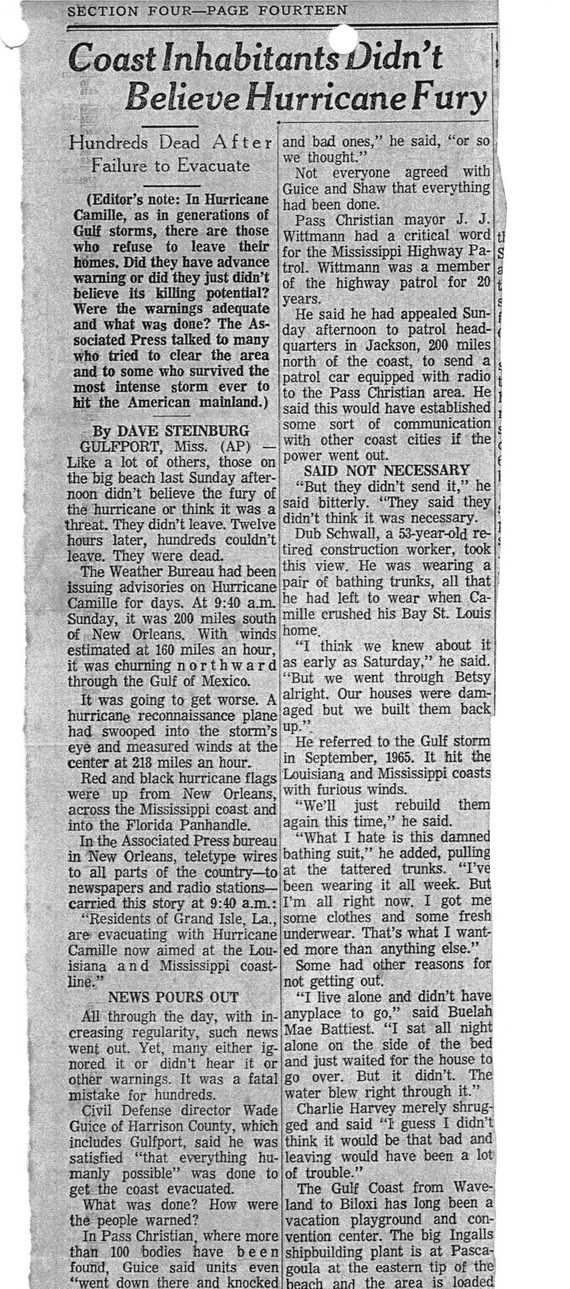This text was obtained via automated optical character recognition.
It has not been edited and may therefore contain several errors.
SfeCTION FOUR—PAGE FOURTEEN
Coast Inhabitants Didn’t ! Believe Hurricane Fury
Hundreds Dead After Failure to Evacuate
(Editor’s note: In Hurricane Camille, as in generations of Gulf storms, there are those who refuse to leave their homes. Did they have advance warning or did they just didn’t believe its killing potential? Were the warnings adequate and what was done? The Associated Press talked to many who tried to clear the area and to some who survived the most intense storm ever to hit the American mainland.)
By DAVE STEINBURG GULFPORT, Miss. (AP) — Like a lot of others, those on the big beach last Sunday afternoon didn’t believe the fury of the hurricane or think it was a threat. They didn’t leave. Twelve hours later, hundreds couldn’t leave. They were dead.
The Weather Bureau had been issuing advisories on Hurricane Camille for days. At 9:40 a.m. Sunday, it was 200 miles south of New Orleans. With winds estimated at 160 miles an hour, it was churning northward through the Gulf of Mexico.
It was going to get worse. A hurricane reconnaissance plane had swooped into the storm’s eye and measured winds at the center at 218 miles an hour.
Red and black hurricane flags were up from New Orleans, across the Mississippi coast and into the Florida Panhandle.
In the Associated Press bureau in New Orleans, teletype wires to all parts of the country—to newspapers and radio stations— carried this story at 9:40 a.m.: “Residents of Grand Isle, La., are evacuating with Hurricane Camille now aimed at the Louisiana and Mississippi coastline.”
NEWS POURS OUT All through the day, with increasing regularity, such news went out. Yet, many either ignored it or didn’t hear it or other warnings. It was a fatal mistake for hundreds.
Civil Defense director Wade Guice of Harrison County, which includes Gulfport, said he was satisfied “that everything humanly possible” was done to get the coast evacuated.
What was done? How were the people warned?
In Pass Christian, where more than 100 bodies have been found, Guice said units even “went down there and knocked
and bad ones,” he said, “or so we thought.”
Not everyone agreed with Guice and Shaw that everything had been done. i
Pass Christian mayor J. J. Wittmann had a critical word tl for the Mississippi Highway Pa- g trol. Wittmann was a member a of the highway patrol for 20 t years. s
He said he had appealed Sun- J day afternoon to patrol head- < quarters in Jackson, 200 miles north of the coast, to send a , patrol car equipped with radio { to the Pass Christian area. He j said this would have established 5 some sort of communication , with other coast cities if the J power went out. (
SAID NOT NECESSARY “But they didn’t send it,” he said bitterly. “They said they , didn’t think it was necessary. !
Dub Schwall, a 53-year-old re- j tired construction worker, took ‘ this view. He was wearing a ' pair of bathing trunks, all that he had left to wear when Camille crushed his Bay St. Louis home.
“I think we knew about it as early as Saturday,” he said. “But we went through Betsy alright. Our houses were damaged but we built them back up.”.
He referred to the Gulf storm in September, 1965. It hit the Louisiana and Mississippi coasts with furious winds.
“We’ll just rebuild them again this time,” he said.
“What I hate is this damned bathing suit,” he added, pulling at the tattered trunks. “I’ve been wearing it all week. But I’m all right now. I got me some clothes and some fresh underwear. That’s what I wanted more than anything else.” Some had other reasons for not getting out.
“I live alone and didn’t have anyplace to go,” said Buelah >Iae Battiest. “I sat all night alone on the side of the bed and just waited for the house to go over. But it didn’t. The water blew right through it.” Charlie Harvey merely shrugged and said “I guess I didn’t think it would be that bad and leaving would have been a lot of trouble.”
The Gulf Coast from Waveland to Biloxi has long been a vacation playground and convention center. The big Ingalls shipbuilding plant is at Pascagoula at the eastern tip of the heaoh anH the area is loaded

Hurricane Camille Camille-Aftermath-Media (141)